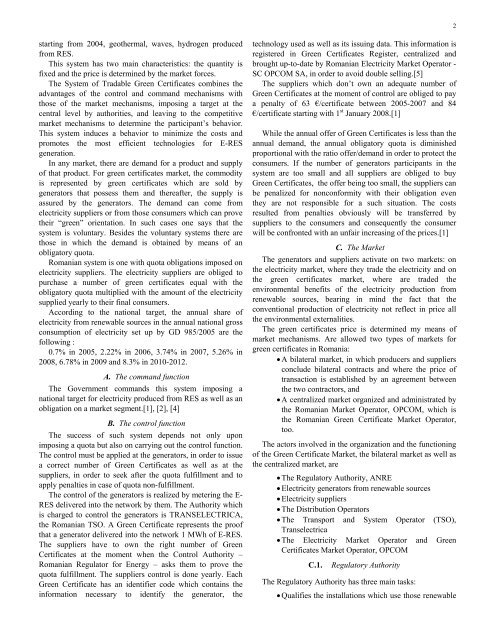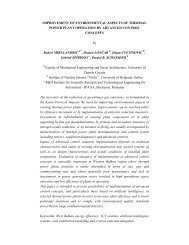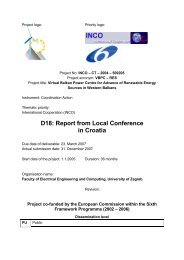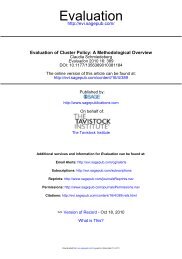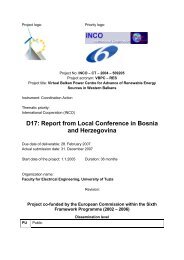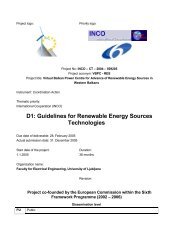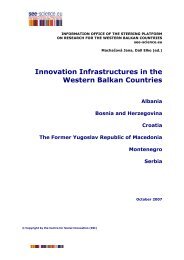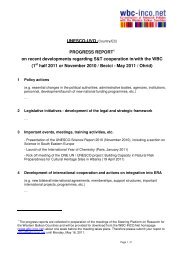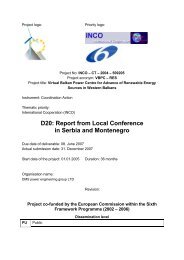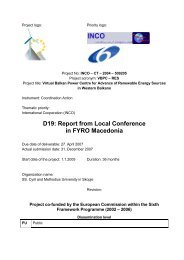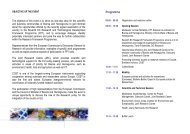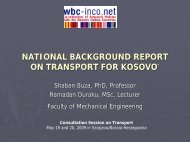Prva stran - WBC-INCO Net
Prva stran - WBC-INCO Net
Prva stran - WBC-INCO Net
You also want an ePaper? Increase the reach of your titles
YUMPU automatically turns print PDFs into web optimized ePapers that Google loves.
starting from 2004, geothermal, waves, hydrogen produced<br />
from RES.<br />
This system has two main characteristics: the quantity is<br />
fixed and the price is determined by the market forces.<br />
The System of Tradable Green Certificates combines the<br />
advantages of the control and command mechanisms with<br />
those of the market mechanisms, imposing a target at the<br />
central level by authorities, and leaving to the competitive<br />
market mechanisms to determine the participant’s behavior.<br />
This system induces a behavior to minimize the costs and<br />
promotes the most efficient technologies for E-RES<br />
generation.<br />
In any market, there are demand for a product and supply<br />
of that product. For green certificates market, the commodity<br />
is represented by green certificates which are sold by<br />
generators that possess them and thereafter, the supply is<br />
assured by the generators. The demand can come from<br />
electricity suppliers or from those consumers which can prove<br />
their “green” orientation. In such cases one says that the<br />
system is voluntary. Besides the voluntary systems there are<br />
those in which the demand is obtained by means of an<br />
obligatory quota.<br />
Romanian system is one with quota obligations imposed on<br />
electricity suppliers. The electricity suppliers are obliged to<br />
purchase a number of green certificates equal with the<br />
obligatory quota multiplied with the amount of the electricity<br />
supplied yearly to their final consumers.<br />
According to the national target, the annual share of<br />
electricity from renewable sources in the annual national gross<br />
consumption of electricity set up by GD 985/2005 are the<br />
following :<br />
0.7% in 2005, 2.22% in 2006, 3.74% in 2007, 5.26% in<br />
2008, 6.78% in 2009 and 8.3% in 2010-2012.<br />
A. The command function<br />
The Government commands this system imposing a<br />
national target for electricity produced from RES as well as an<br />
obligation on a market segment.[1], [2], [4]<br />
B. The control function<br />
The success of such system depends not only upon<br />
imposing a quota but also on carrying out the control function.<br />
The control must be applied at the generators, in order to issue<br />
a correct number of Green Certificates as well as at the<br />
suppliers, in order to seek after the quota fulfillment and to<br />
apply penalties in case of quota non-fulfillment.<br />
The control of the generators is realized by metering the E-<br />
RES delivered into the network by them. The Authority which<br />
is charged to control the generators is TRANSELECTRICA,<br />
the Romanian TSO. A Green Certificate represents the proof<br />
that a generator delivered into the network 1 MWh of E-RES.<br />
The suppliers have to own the right number of Green<br />
Certificates at the moment when the Control Authority –<br />
Romanian Regulator for Energy – asks them to prove the<br />
quota fulfillment. The suppliers control is done yearly. Each<br />
Green Certificate has an identifier code which contains the<br />
information necessary to identify the generator, the<br />
technology used as well as its issuing data. This information is<br />
registered in Green Certificates Register, centralized and<br />
brought up-to-date by Romanian Electricity Market Operator -<br />
SC OPCOM SA, in order to avoid double selling.[5]<br />
The suppliers which don’t own an adequate number of<br />
Green Certificates at the moment of control are obliged to pay<br />
a penalty of 63 €/certificate between 2005-2007 and 84<br />
€/certificate starting with 1 st January 2008.[1]<br />
While the annual offer of Green Certificates is less than the<br />
annual demand, the annual obligatory quota is diminished<br />
proportional with the ratio offer/demand in order to protect the<br />
consumers. If the number of generators participants in the<br />
system are too small and all suppliers are obliged to buy<br />
Green Certificates, the offer being too small, the suppliers can<br />
be penalized for nonconformity with their obligation even<br />
they are not responsible for a such situation. The costs<br />
resulted from penalties obviously will be transferred by<br />
suppliers to the consumers and consequently the consumer<br />
will be confronted with an unfair increasing of the prices.[1]<br />
C. The Market<br />
The generators and suppliers activate on two markets: on<br />
the electricity market, where they trade the electricity and on<br />
the green certificates market, where are traded the<br />
environmental benefits of the electricity production from<br />
renewable sources, bearing in mind the fact that the<br />
conventional production of electricity not reflect in price all<br />
the environmental externalities.<br />
The green certificates price is determined my means of<br />
market mechanisms. Are allowed two types of markets for<br />
green certificates in Romania:<br />
• A bilateral market, in which producers and suppliers<br />
conclude bilateral contracts and where the price of<br />
transaction is established by an agreement between<br />
the two contractors, and<br />
• A centralized market organized and administrated by<br />
the Romanian Market Operator, OPCOM, which is<br />
the Romanian Green Certificate Market Operator,<br />
too.<br />
The actors involved in the organization and the functioning<br />
of the Green Certificate Market, the bilateral market as well as<br />
the centralized market, are<br />
• The Regulatory Authority, ANRE<br />
• Electricity generators from renewable sources<br />
• Electricity suppliers<br />
• The Distribution Operators<br />
• The Transport and System Operator (TSO),<br />
Transelectrica<br />
• The Electricity Market Operator and Green<br />
Certificates Market Operator, OPCOM<br />
C.1. Regulatory Authority<br />
The Regulatory Authority has three main tasks:<br />
• Qualifies the installations which use those renewable<br />
2


